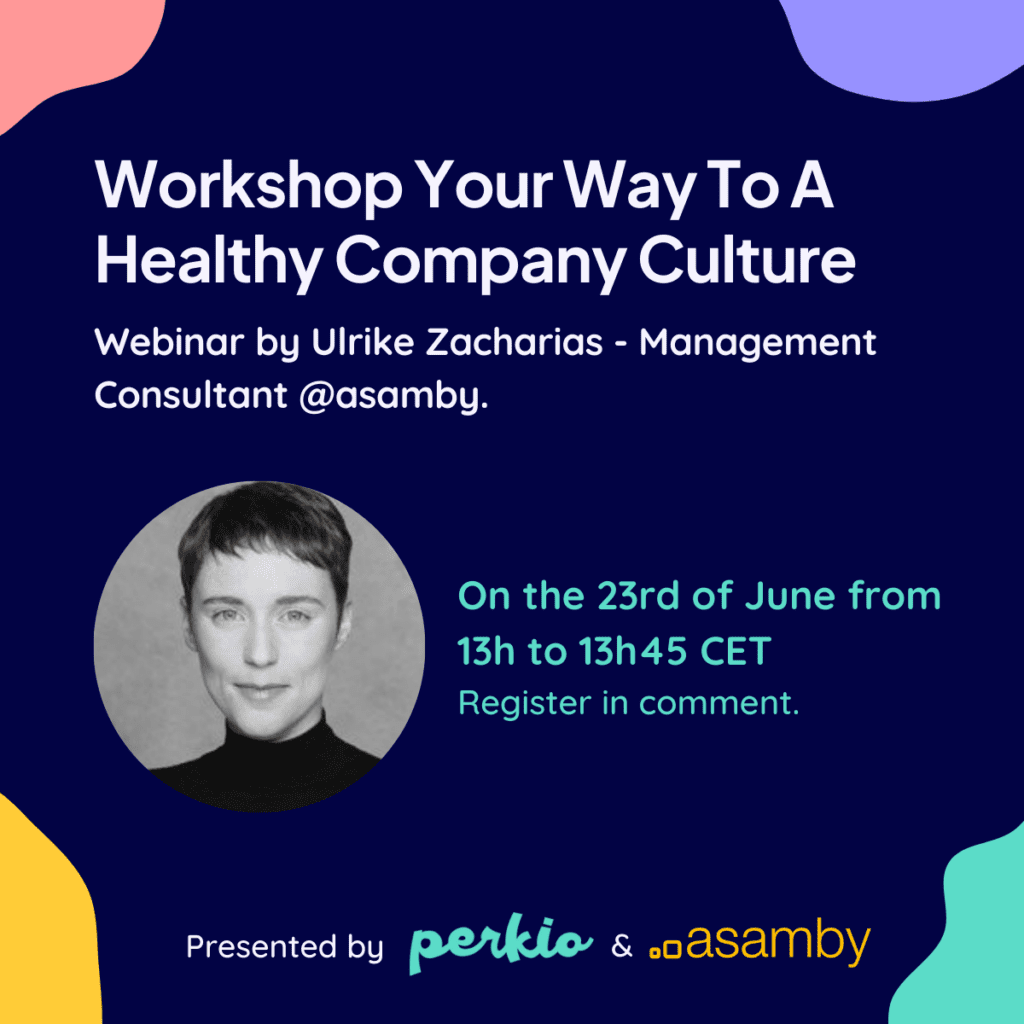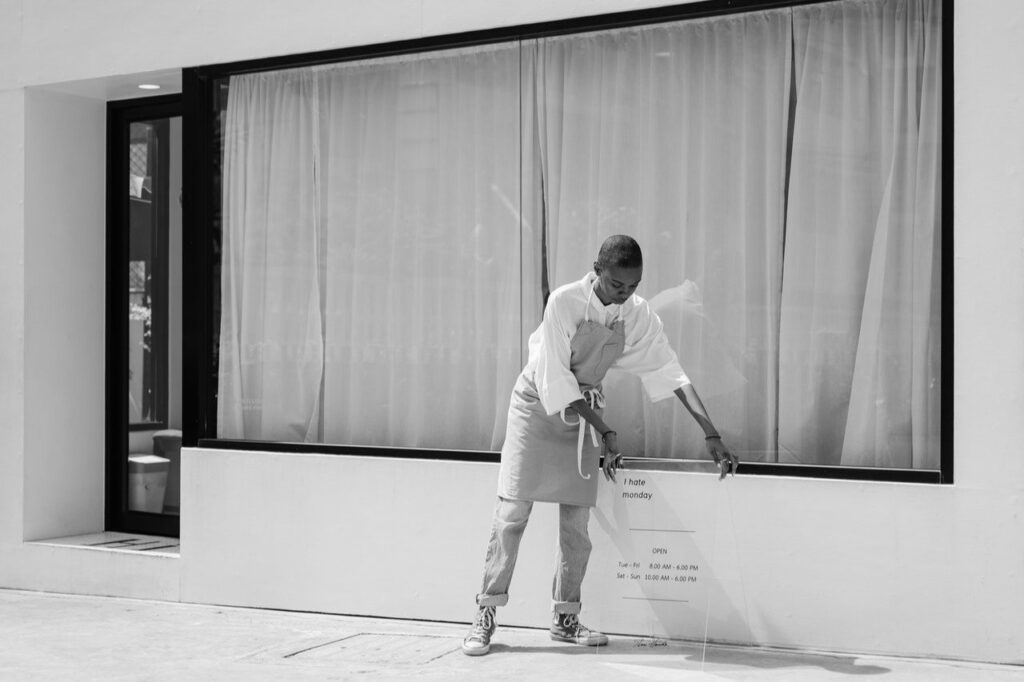
This article will explore the rise of organizational culture as a key element for healthy organizations, and how it can become a competitive advantage for SMEs. We will shed light on the historical influence a performance-driven culture had on the workforce and explain the shift to a more human-centric approach.
Be prepared to enter a decade of culture-aware companies, rather than push-harder work ethics, with one-sided goals and dreaded performance reviews.
ORGANIZATIONAL CULTURE IN SHORT
Organizational culture is one of the most important aspects of any business, no matter what size it is. One culture is always present. The Business Dictionary defines organizational culture as:
“The values and behaviors that contribute to the unique social and psychological environment of an organization.” (The Business Dictionary, 2018).
A positive organizational culture can have a significant impact on every aspect of a business. This includes its productivity, performance, customer service, and employee engagement levels.
EVERYTHING HAS ITS TIME
Everything has its time and cycle, as Nicolai Kondratieff (Kondratiev) prominently showed with the long-term economic cycles. The K-waves (or Super Waves) refer to cycles, lasting about 40 to 60 years, experienced by capitalist economies, and brought about by technological innovation. In his theory, these technological innovations become the carrier of long-term and worldwide economic growth.
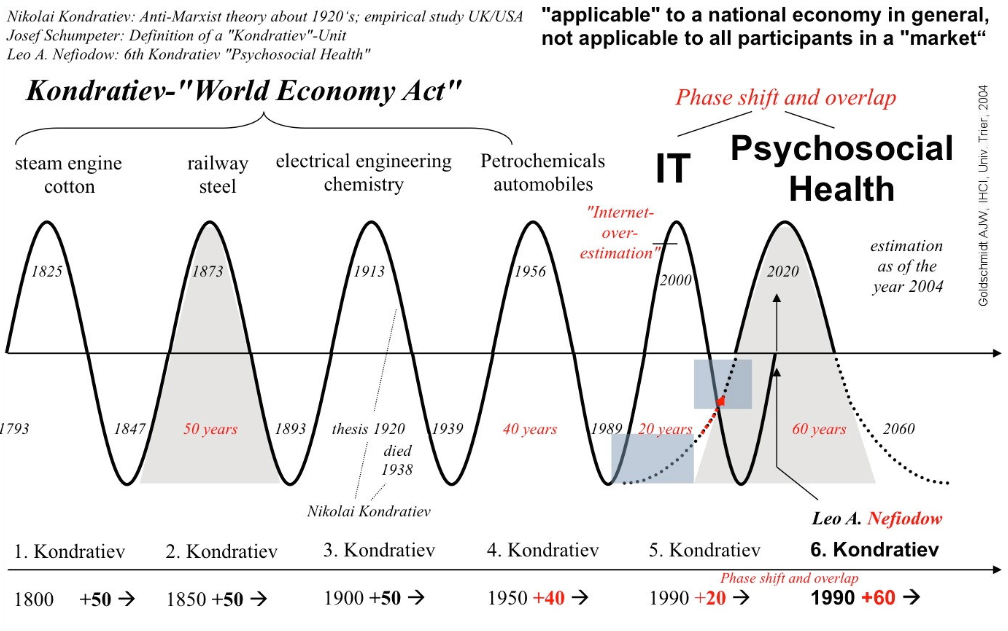
The spring and summer phases of a cycle mark its growth and peak. The autumn phase starts when things ebb down, which ultimately leads to the winter phase, which marks the end of a cycle.
Due to the ongoing efforts of governments to delay inflation and a recession since 2008, we are experiencing an overlap of one phase ending and a new phase beginning (see graphic 1).
When we talk about the historical influence of a performance-driven culture and the current shift to a more human-centric approach in this perspective, one seems to initiate the other. Let’s get back to this after a closer look at the predominant method organizations have used during the last economic cycles to create high-performing teams.
EARLY DAYS OF MANAGEMENT THEORY: WHEN APPRAISALS WERE BORN
The roots of performance management stem from the early 1900s. Yes, that’s right, 120 years ago. These were the wild early days of classic management theory, pioneered by e.g. F. W. Taylors Management Theory, and Mary Parker Follett laying the foundation for matrix-style.
All of these theories added a more systematic assessment and approach to how organizations are run.
In the 1920s, the Australian Walter D. Scott is documented as one of the earliest sources of performance appraisals, though not widely recognized at the time. Performance appraisals were mainly used in his own consultancy firm. Yet, he influenced the concept of the performance management we know today.
In the mid-century, the concept gained real traction and was applied in many larger and mid-sized companies globally. The approach to setting goals, and monitoring performance, including personalized appraisals, followed by employee self-assessments developed gradually (see timeline graphic 2).
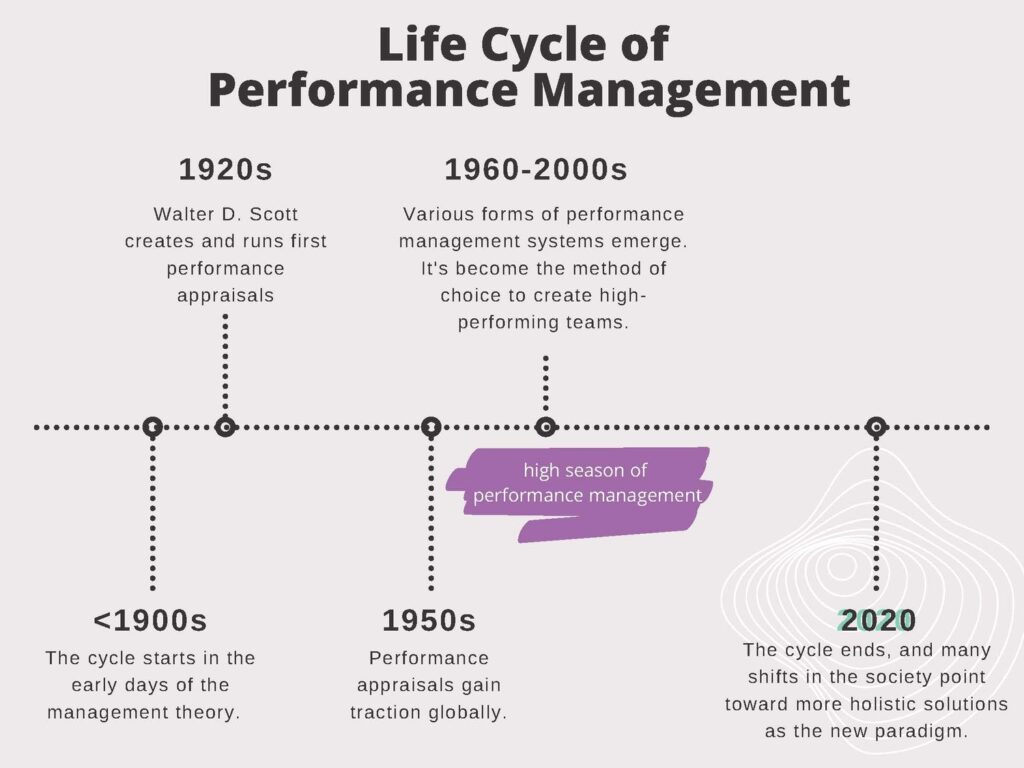
Extra trimmings, such as the balance scorecard, or the (still controversial) forced ranking by Jack Welch (former General Electric CEO), add a stark competition mindset by ranking or rating employees against their coworkers. Mr. Welch suggested, that the bottom 10 percent of employees are supposed to be eliminated.
The emergence of performance management shows its own spring, summer, and autumn phases. It is foreseeable, that winter indeed is coming.
Chances are if someone is working for 3+ years, they’d had some sort of goal setting, and experienced said appraisals. Check-in with yourself, if you’ve worked in a more or less strict goal-oriented environment:
- How did it feel working in a goal-driven work environment?
- How was the process managed by the superior?
- How did you feel prior to appraisal season?
- In which way did it affect work ethic and performance throughout the year?
- What had to give way, in order to achieve the set goals and only those?
- Was there space for discovery/creativity throughout the goal-laden work year?
- Did you feel self-directed, fulfilled, and empowered to reach your potential – some of the human needs most of us long for?
- Which work culture was created by the goal-setting and was it a desirable one?
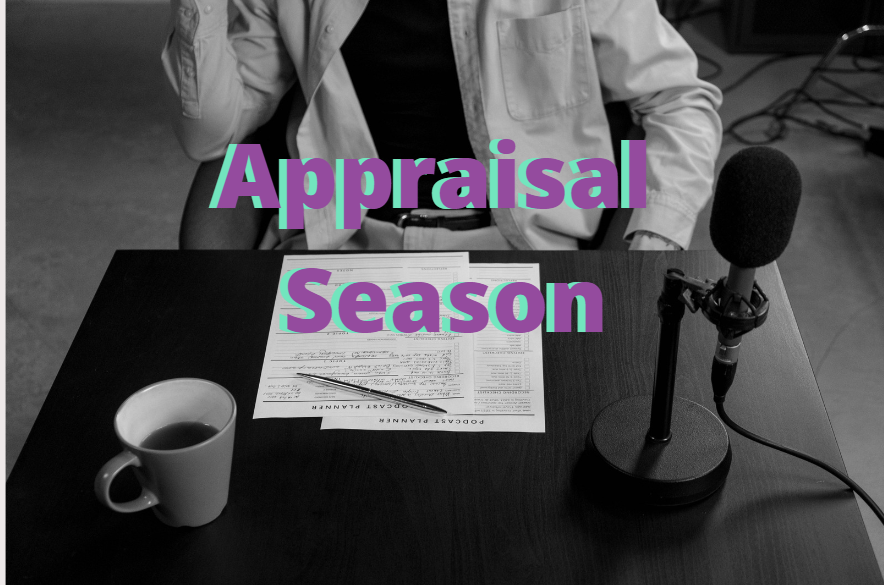
SEEING RELATIONS FROM CULTURAL AND PERFORMANCE DATA POINTS
If we take a closer look at cultural and performance data points, we can see some interesting correlations between them.
A researcher wrote in the Journal of Organizational Behavior “Overall, department culture was found to consistently predict higher subsequent levels of customer satisfaction ratings and […] sales, with no evidence obtained for a reciprocal performance-to-culture feedback loop. In addition, the positive effect of culture on […] sales were mediated by customer satisfaction.”
Simply said, engaged culture is characterized by:
- High levels of participation,
- Stability,
- Adaptability, and
- A clear objective
If these are present for the employees, it can boost sales and customer happiness in return. The Queen’s University Center for Business Venturing adds to the evidence that culture and performance are linked. It discovered the following for firms with an engaged culture, based on data from employee engagement surveys and corporate outcomes over a ten-year period:
- 65% greater share-price increase
- 26% less employee turnover
- 100% more unsolicited employment applications
- 20% less absenteeism
- 15% greater employee productivity
- 30% greater customer satisfaction levels.
WHAT’S THE BOTTOM LINE?
What’s the end result of decades of building a mostly goal-oriented workforce? Is it possible that this resulted in a poisonous work environment? Is this business-centered culture to blame for the all-time high in mental health cases? What about the reality that people want greater meaning and purpose in their jobs? Employees also want the freedom to work according to their own schedules and conditions.
Looking at the cycles, the contemporary social shifts, and the aftermath of the pandemic, it appears that the move to organizational culture as the new, holistic driver of employee engagement, creativity, innovation, performance, and retention has arrived.
The research data further suggest, that creating the right culture in the first place, forming a team that is living and breathing the distinctive culture of the organisation.
THE NEXT CYCLE – PSYCHOSOCIAL HEALTH AND ITS CONNECTION TO ORGANIZATIONAL CULTURE
Leo A. Nefiodow provided a new outlook in 2014 when he forecasted the phase following the 2000s IT cycle the cycle of psychosocial health (see graphic 1, more insights here). Interesting, right? That doesn’t sound like technological innovation, at least not right away.
So what is psychosocial health then?
Psychosocial health encompasses a state of mental, emotional, social, and spiritual well-being. This definition extends to a person’s past, their views of the present, and hopes for the future, along with how they cope under stress and pressure. Essentially, psychosocial health is the mental and emotional well-being of a person, as it relates to their identity and how others perceive them.
Since we all exist many hours of our waking life in work environments, much attention should go to this habitat, when assessing psychological health and its effects in the next cycle.
The next cycle is about how we can bring people together, and make sure they are happy. This is not just about the business and work environment but also about the people who work there.
According to Schein (1990), culture defines many things. Different values and actions that can be seen as a guide to success. According to Kotter and Heskett (1992), culture means fairly established set of beliefs, behaviors and values of society. Simply put, culture is gained knowledge, explanations, values, beliefs, communication and behaviors of large group of people, at the same time and same place. This is where organizational culture is precisely what we have to consider.
One of the many drivers of organizational culture, making it a key element for the future of work, was the pandemic. This is supported by the pandemic effect coined by Berkeley-Stanford “Silver Linings” Study (see graphic 3). The study states:
“Organizational cultures in the pandemic era have generally shifted away from a high-performance orientation to one that prizes empathy, understanding, and mutual support.”
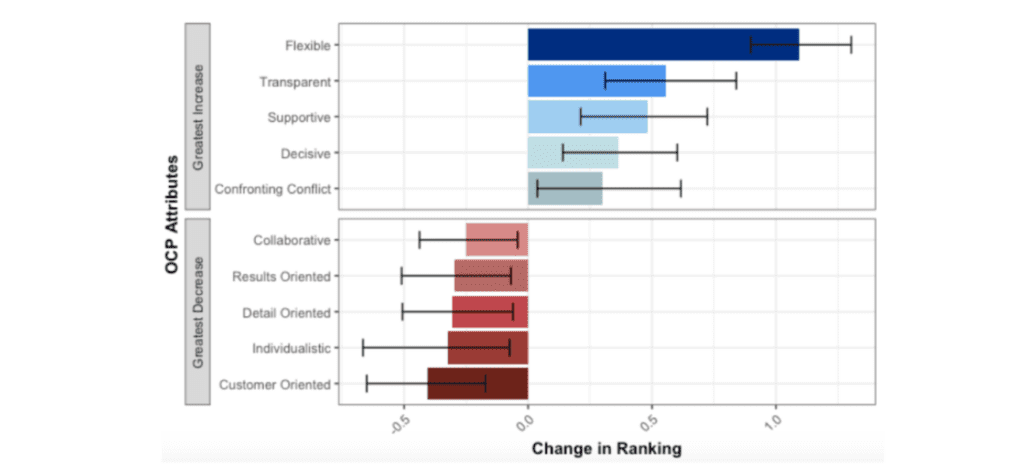
Organizational culture in SMEs
SMEs have a more organic culture than big organizations. Due to their size, they can also move faster than big global corporations. It’s basically a competitive advantage itself. And this comes in handy when small organizations prepare to adapt to a new business opportunity or technological innovation.
This is also, why I love working with small businesses, because you can create impact and results fast with smaller teams with multidisciplinary experts.
SME-SPECIFIC BENEFITS OF CULTURE DESIGN
Effective cultural design improves organizational performance by 226% (Shahzad, F. et al.). A healthy company culture reduces the number of sick days by over 25% according to Bluquist – a team analytics software. Especially for small teams, this means the difference between survival and success. During disruptive (post-pandemic) changes and a shortage of skilled workers, a competitive advantage and performance driver like a healthy culture becomes even more beneficial for SMEs.
Whether you’re building a new business, innovating the customer and employee experience, transforming, or driving audience engagement, culture determines success. One thing is certain, the culture develops whether you like it or not. Design with intent and evolve with intent to ensure your compani’s success.
As Consultants, we often get asked, what is culture? It’s the vibe of the (digital) room and the way a team interacts with one another. It’s how victories are celebrated, large and small, and how innovation is created. However, it is not the easiest task to assess culture, e.g. the team’s morale and how it is maintained. Here are some elements where culture is showing:
IN STRUCTURES
- Power structures
- Control systems
- The recognition system and benefits offered
- Informal rules and expectations
IN COMMUNICATION
- Mission and Vision
- Company Values and philosophy
- Tone and voice in Slack channels, emails, video calls etc.
- Slogans and catch-phrases the team and leaders use
- The way information is shared and the level of transparency
DURING INTERACTION
- Team rituals
- Also: informal rules and expectations
- Decision-making/consensus finding techniques
- How behavior is tolerated, or not
- How feedback is given and received
How SMEs can enhance their culture
Culture design is a multidisciplinary design approach with a cross-over to experience design, process design, organizational design, and other principles.
We recommend a three-step approach to assess, reflect and change with intent. It may feel like a big task to facilitate such a deep process at first. Try looking at it as a journey to new heights. There is no set goal or final culture here, a culture can not be fully influenced or designed, but it can be enhanced, augmented, and polished. These steps and guidance can guide a small business to intentionally build this process in their organization.
1) ASSESS
Nothing is more individual than the lived culture of a group. You’ll not find the same distinctive culture, its rituals, etc. ever again in another group. As we already assessed, it can be really hard to describe and grasp a culture. This is why an initial step would be, to make the indescribable describable. Some options are:
- Culture assessment
- Informal rules mapping
- Culture-oriented employee surveys
- Ritual spotting
- Tailored workshops with the team
- Individual team member assessments (e.g. using bluquist)
- Etc.
2) REFLECT
After the assessment, it is advisable to sit with the data and digest what has been unearthed. May it be an overview of cultural dimensions present in the company, or a map showing informal rules that have long been lingering and have now been put in writing.
From a cultural transformation perspective, we are now at the beginning of a change phase. People involved may feel anything from surprise to shock. This is an important step along the way toward a more desirable, healthy company culture. The spectrum of emotions may be broad. If you sense denial, euphoria, or pride in the team, let there be space.
Depending on the communication tools you are using, leaders may guide the team with some of the following tools following the show of results:
- Share questions for self-reflection
- Offer mindfulness activities in groups
- Monitor team wellbeing with regular pulse-checks (anonymous)
- Offer additional 1-on-1 time with leaders
- Tailored initiatives to celebrate (perhaps a team ritual)
- Have a meal together (also possible remote)
- Etc.
3) CHANGE
This is the step where elements supporting a new culture and the transformation process leading there are designed. It’s a highly individual, creative process and there is no blueprint for it. We recommend treating this as a stand-alone change project with a roadmap, initiative plan, and supporting initiatives, e.g. for focus groups. Some design principles that can be used in this step are:
- Behavioral design framework
- Ritual design
- Tailored team workshops
- Experience design principles
- Process and interaction design
- Change & transformation initiatives design
- Employer branding elements
- Etc.
Final thoughts
A few years back, the concept of intentionally designing a company culture was unheard of. With the exception of change management projects or employer branding initiatives, where culture was indeed addressed. But the culture was not recognized in the same way as it is gaining importance now. Like other change and transformation projects, cultural change is a step-by-step process that doesn’t happen in a few weeks. Each individual works through their unique (emotional) change curve in their own adjustment speed. The range of adaptability to change is wider than we often think.
When undergoing a cultural change project, we carefully assess the audience with a mix of instruments. This enables us to offer tailored change communication and support initiatives/touchpoints, and smoothly guide the team towards the new. We offer different opportunities for the employees to collaborate in the design phase and collect feedback (or add additional feedback loops if we see the need).
DO YOU WANT TO GET HANDS ON?
📌 Join our upcoming webinar in cooperation with Perkio. You can register here.
Click here to download the free reference to the company culture checklist.
